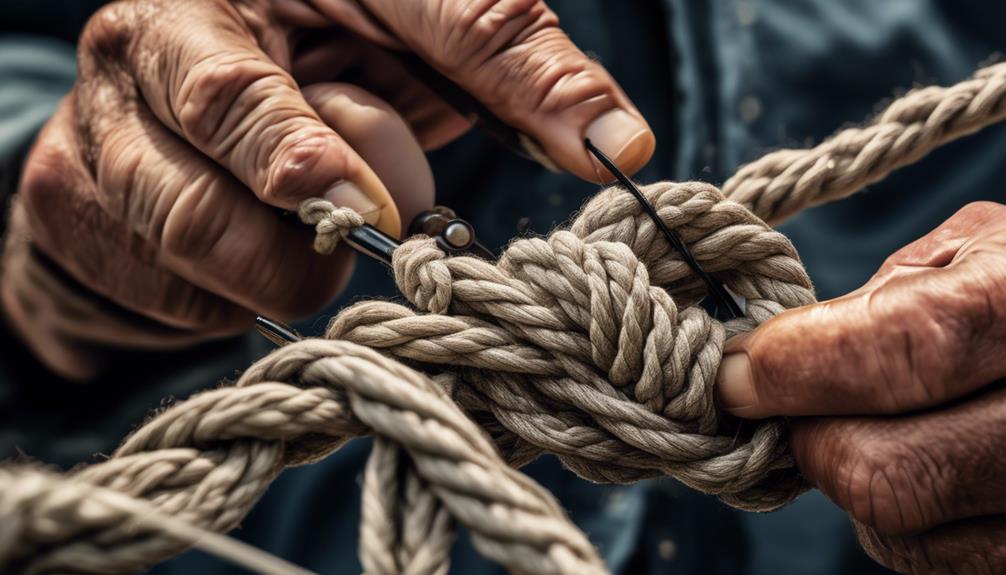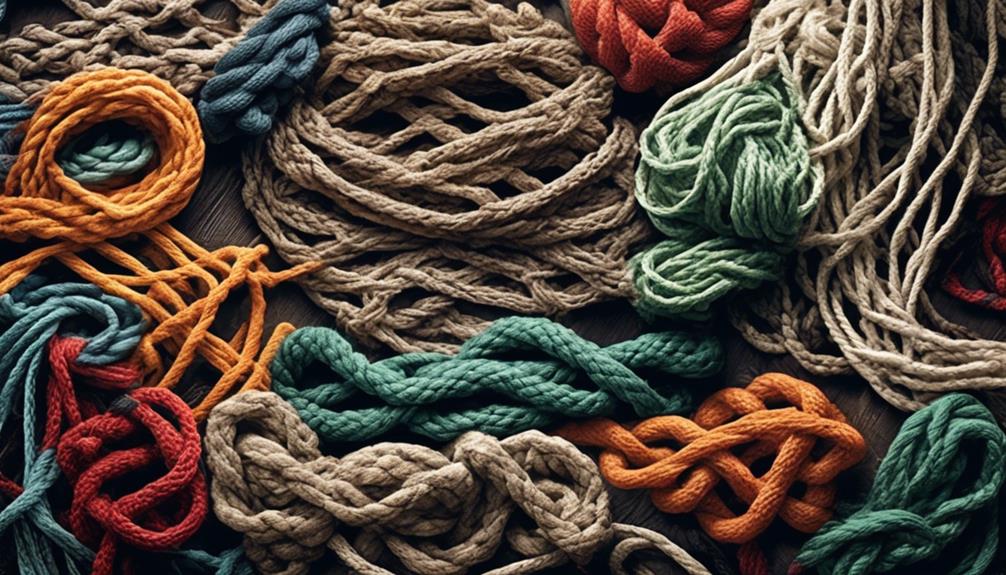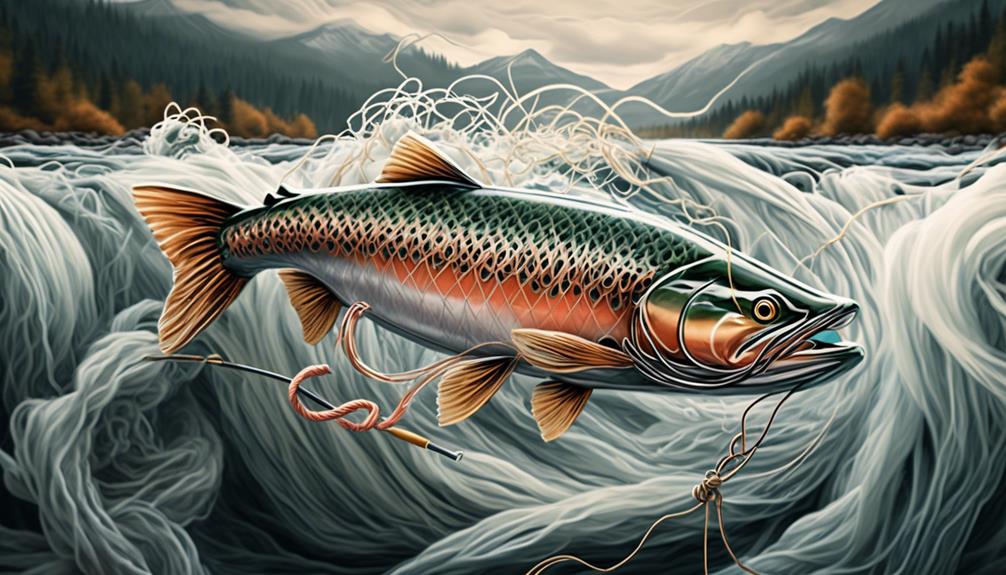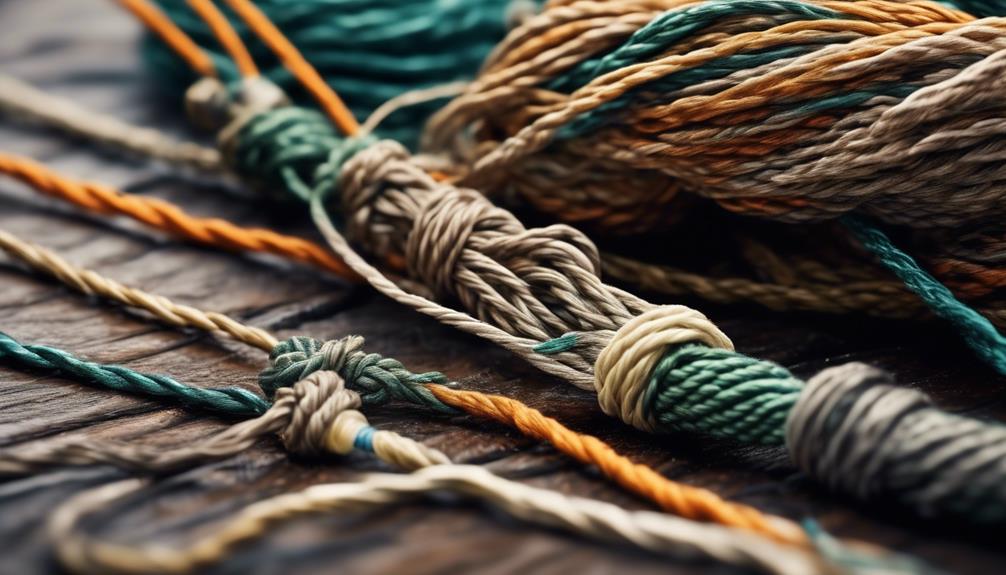You might be thinking, 'Do I really need to learn eight different fishing knots?' The answer is yes, and here's why.
Pro anglers swear by these top 8 fishing knots for a reason – they're versatile, reliable, and can make or break your fishing success.
Whether you're targeting bass, trout, or saltwater species, mastering these knots will give you the edge you need to handle any fishing situation.
So, which knots are these pros using, and why are they so highly regarded?
Palomar Knot
Learn how to tie the Palomar Knot, a favorite among pro anglers for its simplicity and reliability. The Palomar knot's primary advantage lies in its strength and ease of tying. It's known for retaining almost the full breaking strength of the line, making it a popular choice for securing hooks and lures. Additionally, the simplicity of its structure makes it easy to learn and remember, even for beginners. However, one potential disadvantage of the Palomar knot is that it may not be suitable for lines larger than 25-pound test, as it can become difficult to cinch properly.
To tie the Palomar knot successfully, start by doubling the line and passing it through the eye of the hook or lure. Then, tie a simple overhand knot with the doubled line, creating a loop large enough to pass the hook or lure through. After moistening the knot, pull both ends of the line to tighten it. One common mistake when tying the Palomar knot is failing to ensure that the knot is lubricated before cinching it down, which can weaken the line. Another mistake to avoid is leaving the loop too small, as this can also reduce the knot's strength.
Mastering the Palomar knot is a valuable skill for any angler, offering both strength and simplicity. With these tying tips and awareness of potential mistakes, you can confidently add this reliable knot to your fishing repertoire.
Improved Clinch Knot
The Improved Clinch Knot is a versatile and reliable fishing knot used to secure hooks, lures, and swivels to the fishing line. It's a popular choice among anglers due to its strength and ease of tying. When it comes to the benefits and drawbacks of the Improved Clinch Knot, consider the following:
- Benefits:
- Provides a strong and secure connection between the line and the hook, lure, or swivel, giving you confidence when battling feisty fish.
- Versatile and suitable for various types of fishing lines and situations, making it a go-to knot for many anglers.
- Relatively easy to tie, even in adverse weather conditions or low light, ensuring you can quickly get back to fishing.
- Drawbacks:
- May slip with certain types of lines or when tied incorrectly, potentially leading to lost fish or gear.
- Involves a few more steps compared to some other knots, which might be a downside for those seeking a quicker knotting process.
As for tips and tricks for tying the Improved Clinch Knot, consider the following advice to help you master this essential fishing knot:
- Wet the line before tightening the knot to reduce friction and heat, which can weaken the line.
- Ensure that you make at least 5-7 turns when wrapping the tag end around the standing line for optimal strength.
- After cinching the knot, trim the tag end closely to the knot to prevent interference with the bait or lure.
Uni Knot
When tying the Uni Knot, make sure to pass the tag end through the hook eye and double back parallel to the standing line.
The Uni Knot is a versatile and reliable knot that's favored by many pro anglers for its strength and various applications. This knot is known for its exceptional strength, making it suitable for securing hooks, swivels, and joining lines. The uni knot strength is derived from its ability to distribute pressure evenly along the entire length of the knot, minimizing the risk of breakage when battling large fish or navigating through rugged underwater terrain.
One of the key advantages of the Uni Knot is its wide range of applications. Anglers commonly use this knot to tie on hooks, attach lures or flies, join lines of different diameters or materials, and secure swivels or snaps. Its flexibility and reliability have made it a go-to choice for both freshwater and saltwater fishing.
Whether you're casting for bass in a freshwater pond or targeting tuna in the open ocean, the Uni Knot provides the necessary strength and security for various fishing scenarios.
San Diego Jam Knot
The Uni Knot's versatility and reliability make it a favorite among pro anglers. However, when securing larger hooks or dealing with particularly strong fish, you may find the San Diego Jam Knot to be an even better option.
The San Diego Jam Knot, also known as the Reverse Clinch Knot, is highly favored for its knot strength and fishing line compatibility. Here's why you should consider using the San Diego Jam Knot:
- Exceptional Knot Strength: The San Diego Jam Knot is renowned for its exceptional knot strength. It is an ideal choice when targeting larger, hard-fighting fish species. The knot's ability to withstand heavy loads and intense pressure provides peace of mind, especially when battling trophy fish.
- Versatile Fishing Line Compatibility: This knot is compatible with a wide range of fishing lines, including monofilament, fluorocarbon, and braided lines. Its versatility allows anglers to use it across various fishing scenarios, from freshwater bass fishing to offshore big game fishing, without compromising on strength or reliability.
- Confidence in Challenging Situations: Whether you're tackling aggressive saltwater species or casting into dense cover where fish are likely to wrap your line around obstacles, the San Diego Jam Knot instills confidence. Its robust and secure design minimizes the risk of line breakage, ensuring you remain in control during intense battles.
Double Uni Knot
Looking to double up the strength of your connections? The Double Uni Knot is a reliable and versatile choice for securing lines and joining two lines together in fishing applications. When it comes to line strength, the Double Uni Knot is a top performer. It maintains a significant portion of the line's original strength, making it suitable for both monofilament and braided lines. This knot is particularly effective for connecting lines of different materials and diameters, making it a valuable knot for various fishing applications.
The tying process for the Double Uni Knot is relatively straightforward. Start by overlapping the ends of the two lines to be joined. Form a loop with the first line and pass the tag end through the loop and around both lines 3-4 times. Moisten the knot and pull it tight by holding the tag end and the two lines.
Repeat the same process with the second line, wrapping it around the first line. The Double Uni Knot offers great versatility with variations such as the Double Uni Knot for joining lines of different diameters, and the Double Uni Knot for connecting a leader to the main line. With its ease of tying and adaptability to various fishing scenarios, the Double Uni Knot is a favorite among pro anglers.
Blood Knot
Interested in a knot that excels at joining two lines of similar or different diameters for a strong and reliable connection? Look no further than the Blood Knot. This classic knot is renowned for its strength and versatility, making it a favorite among pro anglers for various fishing scenarios.
When you master the art of tying the Blood Knot, you'll experience a sense of accomplishment and confidence in your fishing skills. The feeling of creating a secure connection between two different lines evokes a sense of pride and satisfaction, knowing that you have the ability to tackle even the toughest fishing challenges.
As you learn about the tying process and applications of the Blood Knot, you'll appreciate its simplicity and effectiveness. The process of intricately wrapping and weaving the lines together creates a bond that feels almost poetic, emphasizing the connection between the angler, the gear, and the fish.
Moreover, the knowledge that this knot can be used for various fishing techniques and scenarios instills a sense of readiness and adaptability, empowering you to take on diverse fishing adventures with confidence.
Albright Knot
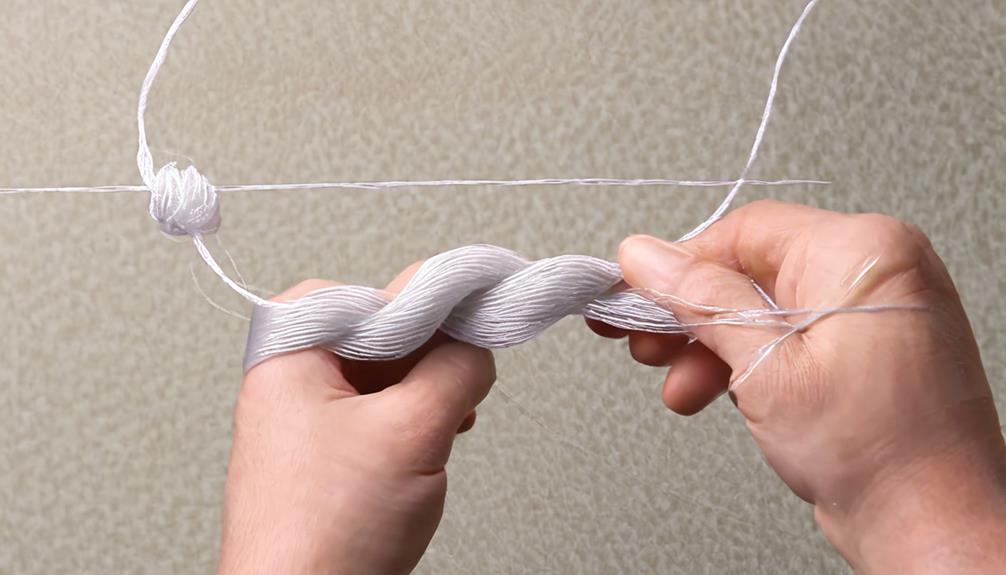
Mastering the Blood Knot has undoubtedly honed your skills in connecting different lines, and now, let's explore the strength and versatility of the Albright Knot for securing a smooth and reliable connection.
The Albright knot strength is particularly impressive, making it a favorite among anglers for joining different types of lines, especially when attaching a leader to a heavier mainline. Its design allows for a streamlined connection, minimizing the risk of snagging or tangling during casting and retrieval.
One of the primary Albright knot applications is in saltwater fishing, where the knot's ability to smoothly join lines of differing diameters is crucial for handling large, powerful fish. The knot's reliability under heavy stress makes it a go-to choice for targeting species like tarpon, snook, and tuna.
Additionally, the Albright Knot is favored in fly fishing, especially for connecting the backing to the fly line. Its slim profile allows for easy passage through rod guides, essential for seamless casting and reeling in feisty trout or salmon.
Understanding the Albright knot strength and its versatility opens up a world of possibilities for tackling various fishing scenarios. Whether you're battling trophy-sized saltwater predators or delicately presenting a fly to finicky freshwater fish, having confidence in your line connections is paramount.
The Albright Knot offers precisely that – a robust, low-profile link that ensures your tackle performs at its best when the pressure is on.
Surgeon's Knot
The Surgeon's Knot offers a straightforward and reliable method for joining two lines, making it a valuable tool for anglers seeking a strong and secure connection. This knot is highly favored for its simplicity and efficiency, allowing you to tie it quickly, even in low light or adverse weather conditions.
Here's why the Surgeon's Knot is a game-changer for anglers:
- Peace of Mind: With the strength comparison, surgeon's knot stands out as a reliable option, giving you the confidence that your lines are securely joined. This knot is designed to withstand the toughest tugs and pulls, ensuring that your lines stay connected when battling feisty fish.
- Simplicity: The Surgeon's Knot's straightforward tying process means you spend less time fumbling with complicated knots and more time with your line in the water, increasing your chances of a successful catch.
- Versatility: Whether you're using monofilament, fluorocarbon, or braided lines, the Surgeon's Knot adapts seamlessly, offering versatility and reliability across different types of fishing lines.
The Surgeon's Knot's simplicity and strength make it a go-to choice for connecting lines, particularly when you need a secure and dependable link. Its ease of tying and ability to maintain line strength ensure that you can focus on the thrill of the catch rather than worrying about the integrity of your knot.
Frequently Asked Questions
What Are Some Common Mistakes to Avoid When Tying These Fishing Knots?
When tying fishing knots, common mistakes to avoid include rushing the process and not using proper technique.
Ensure proper tension to prevent the knot from slipping or breaking.
Another mistake isn't testing the knot's strength before use.
Practice tying the knots correctly and take your time to avoid errors.
Proper technique and attention to detail will help you avoid these common mistakes and ensure your knots are strong and secure.
Are There Any Specific Types of Fishing Lines That Work Best With Each of These Knots?
When it comes to knot compatibility, different fishing lines work best with specific knots. For example, braid lines are often better suited for certain knots due to their strength and lack of stretch, making them ideal for techniques like jigging or topwater fishing.
On the other hand, monofilament lines may work better with different knots, especially for techniques like live bait fishing.
Matching the right knot with the right fishing line can make a big difference in your fishing success.
Can These Knots Be Used for Saltwater Fishing, or Are They More Suitable for Freshwater Fishing?
For saltwater fishing, these knots have their pros and cons. Some may not hold up well in the corrosive saltwater. You can adapt them by using specific types of lines and adding an extra turn for better security.
When transitioning from freshwater to saltwater, consider using thicker lines and practicing tying these knots with wet hands to simulate the saltwater environment. These adjustments will make these knots more suitable for saltwater fishing.
Are There Any Alternative Uses for These Knots Beyond Just Securing Fishing Lines?
Sure!
You can explore creative applications for these knots beyond just securing fishing lines. They offer practical alternatives for everyday use, like securing items in your garage or tying down gear during outdoor activities.
The knots also have unconventional uses, such as crafting, DIY projects, and camping. You might discover unexpected benefits, like using them for gardening or securing items in your vehicle.
Do Any of These Knots Require Special Tools or Equipment to Tie Effectively?
You don't need special tools or equipment for most fishing knot tying techniques. The basic knots can be tied effectively with just your hands and the fishing line.
However, for advanced knot tying methods or if you want to make the process easier, there are special fishing knot tying tools available. These tools can help you tie knots more efficiently and securely, especially in challenging conditions.
Conclusion
So there you have it, the top 8 fishing knots loved by pro anglers.
Whether you're tying on a new lure or connecting two lines, having a solid repertoire of knots is essential for success on the water.
Practice these knots and soon you'll be able to tie them with your eyes closed.
Happy fishing!
